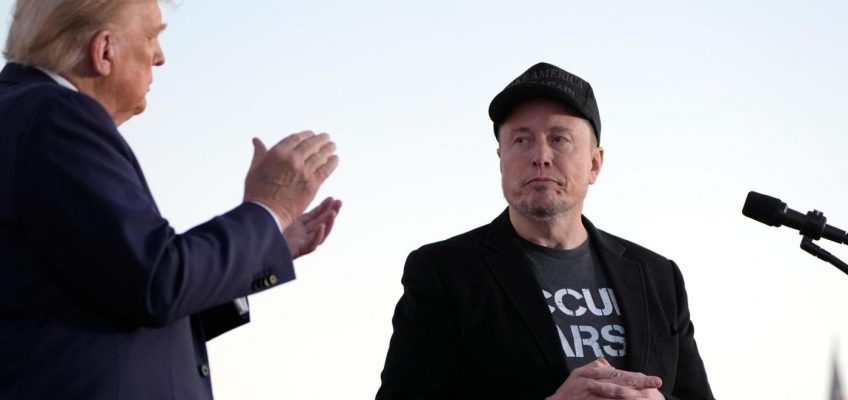By BILL BARROW, Associated Press
ATLANTA (AP) — The Trump administration’s demand that federal agencies plan to radically downsize is driven by a key figure in the conservative movement who has long planned this move.
In President Donald Trump’s first term, Russell Vought was a largely behind-the-scenes player who eventually became director of the influential but underappreciated Office of Management and Budget. He is back in that job in Trump’s second term after being the principal author of Project 2025, the conservative governing blueprint that Trump insisted during the 2024 campaign was not part of his agenda.
The memo Vought co-signed Wednesday is the clearest assertion of his power and the latest seminal writing for a man who argues the federal bureaucracy is an existential threat to the country itself and that it should dramatically downsize. An OMB spokesperson did not immediately respond to a request for comment.
Here is the context of the Wednesday memo and Vought’s previous work:
To Vought, the federal bureaucracy is itself a constitutional crisis
In Wednesday’s memo, Vought framed the federal government as “costly, inefficient, and deeply in debt” and declared that it is “not producing results for the American public. Instead, tax dollars are being siphoned off to fund unproductive and unnecessary programs.”
Related Articles
EPA head urges Trump to reconsider scientific finding that underpins climate action, AP sources say
High-level EU-US diplomatic talks are called off as transatlantic tensions rise
Economic deal between US and Ukraine will tie the countries together for years. Here’s what it says
GOP-led lawsuit that could dismantle disability protections draws public backlash
Egg prices could jump another 41% this year, USDA says, as Trump’s bird flu plan unveiled
He used similar language in passages of Project 2025 and in a 104-page budget plan proposed by his think tank, the Center for Renewing America, in 2022.
“The overall situation is constitutionally dire, unsustainably expensive, and in urgent need of repair. Nothing less than the survival of self-governance in America is at stake,” he wrote in Project 2025.
That tracks with what Vought said before Trump again nominated him to the role in November.
In a post-election appearance with conservative commentator Tucker Carlson, Vought was even more explicit: “The left has innovated over 100 years to create this administrative state … that is totally unaccountable to the president.”
Vought made clear he would leverage a second chance at OMB
In Project 2025, Vought wrote that OMB “is a President’s air-traffic control system” and that “the Director must view his job as the best, most comprehensive approximation of the President’s mind.”
OMB, he wrote, should be “involved in all aspects of the White House policy process,” becoming “powerful enough to override implementing agencies’ bureaucracies.”
He told Carlson that “OMB is the nerve center of the federal budget” and that “it has the ability to turn off the spending that is going on at the agencies” and control “all of government execution.”
Presidents, he said, “use OMB to tame the bureaucracy, the administrative state.”
Speaking with Carlson, Vought described the approach as “radical constitutionalism.”
In his Project 2025 writing, Vought says the OMB director “should present a fiscal goal to the President early in the budget development process” without specifying a date.
Vought has praised DOGE and pushed back at Trump critics
Asked after the election about the president’s proposal to empower billionaire Trump aide Elon Musk and, at the time, former presidential GOP candidate Vivek Ramaswamy, with sweeping power over the federal government, Vought was on board.
“I think they’re bringing an exhilarating rush … of creativity, outside the box thinking, comfortability with risk and leverage,” he told Carlson.
Ramaswamy left DOGE by Inauguration Day.
As for concerns over constitutional separation of powers, meaning those who believe Trump’s White House seeks to takeover spending decisions that rest with Congress, Vought said, “separation of powers is meant to have strong, opinionated conviction and leadership that go as fast as they can and hard as they can in their direction.”
The memo goes into more detail than previous Vought writing
Vought’s latest memo requires agencies to submit an initial overhaul plan by mid-March. This so-called “Phase I” deadline was introduced by Trump.
So-called “Phase II” plans are due by April 14. Among other details, they must include a “future-state organizational chart” and documentation of “all reductions, including (full-time) positions, term and temporary positions, reemployed annuitants, real estate footprint, and contracts.”
Vought invokes religious imagery and texts with his agenda
The latest OMB memo does not venture into religious texts or assertions. But Vought is an outspoken conservative Christian and invokes his faith as part of his governing philosophy.
The Center for Renewing America’s 2022 budget outline begins by quoting the Old Testament, specifically the eighth chapter of the first book of Samuel, to set up a critique of the federal government’s size and scope:
“He will take the best of your fields and vineyards and olive orchards and give them to his servants. He will take the tenth of your grain and of your vineyards and give it to the officers and to his servants … He will take the tenth of your flocks, and you shall be his slaves. And in that day, you will cry out because of your king, whom you have chosen for yourselves.”




